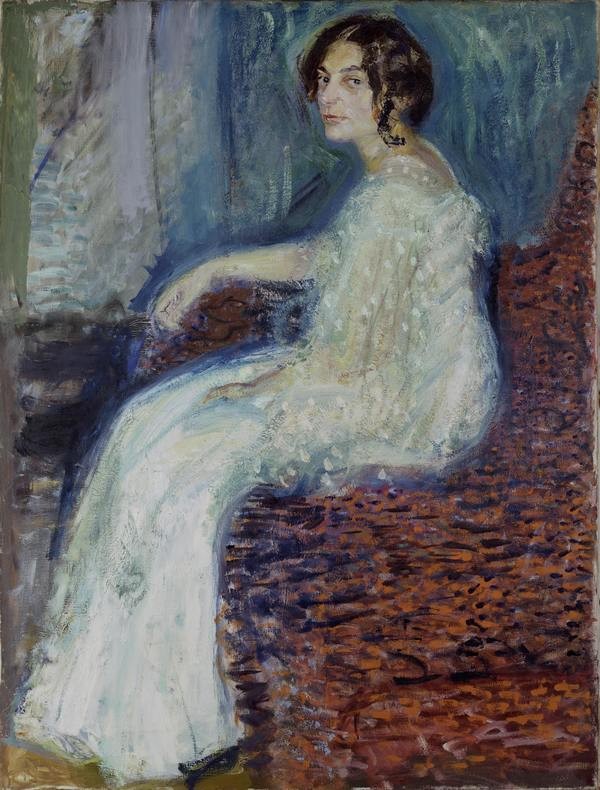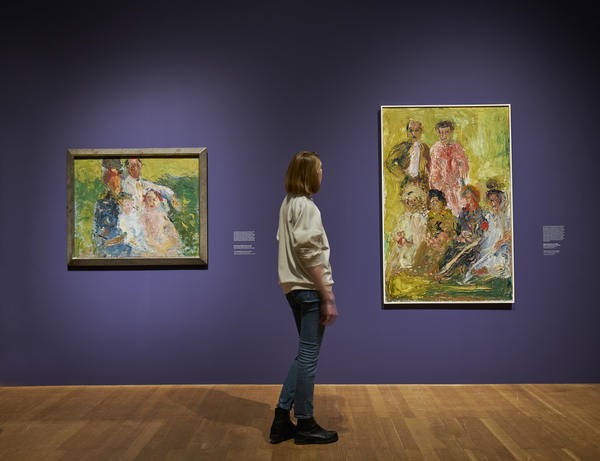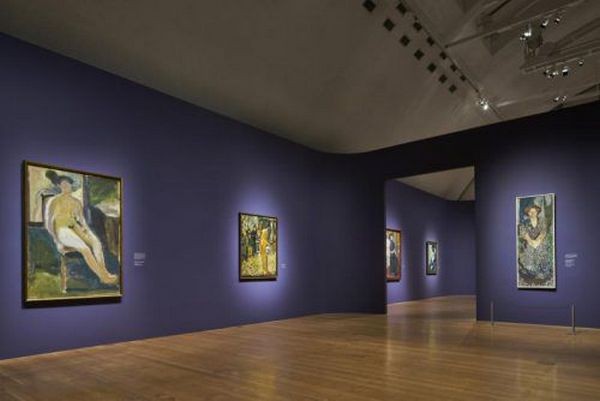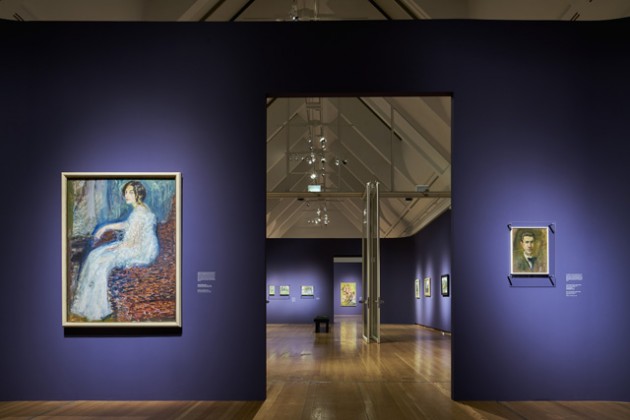Richard Gerstl
Retrospective
24 Feb - 14 May 2017

RICHARD GERSTL, BILDNIS HENRYKA COHN, 1908, OIL ON CANVAS, 147,9 X 111,9 CM, FOTO: © LEOPOLD MUSEUM, WIEN
RICHARD GERSTL
Retrospective
24 February - 14 May 2017
He is the “first Austrian Expressionist,” and for many still an insiders’ tip: the painter Richard Gerstl (1883–1908). He only lived to be 25 years old and yet he is mentioned in the same breath as the great masters of Viennese Modernism: Gustav Klimt, Egon Schiele, and Oskar Kokoschka. During his brief life Gerstl created an exciting and unusual, though relatively limited oeuvre with impressive highlights and pioneering innovations. From February 24 to May 14, 2017, the Schirn Kunsthalle Frankfurt will be presenting the first retrospective of Richard Gerstl’s work in Germany. His painting reflects his concern with the contradictions of modern art. He was a rebel whose paintings opposed the Vienna Secession in terms of both style and content; he rejected their concept of beauty and committed himself to an aesthetic of ugliness. Gerstl loved to provoke and painted against the traditional rules in the conviction that he was treading “completely new paths” in art. He created merciless, confident paintings that do not adhere to earlier models and remain unique to this day. His oeuvre is that of a seeker who anticipated much of what was later articulated by other artists, for example in the paintings of Abstract Expressionism during the 1950s. The portrait, especially the self-portrait, nudes, and landscapes are Gerstl’s preferred genres. The exhibition at the Schirn presents, for example, two of his self-portraits: the earliest one, Semi-Nude Self-Portrait (Selbstbildnis als Halbakt) from 1902/04, and his last, Nude Self-Portrait (Selbstbildnis als Akt) from 1908. Besides portraits such as The Sisters Karoline and Pauline Fey (Die Schwestern Karoline und Pauline Fey) (March/April 1905) and Portrait of Henryka Cohn II (Bildnis Henryka Cohn II) (summer 1908), the exhibition also features the numerous likenesses of Mathilde Schönberg, such as Mother and Daughter (Mutter und Tochter) (late 1906) and Seated Female Nude (Sitzender weiblicher Akt) (fall 1908), as well as portraits of friends and students of the composer Arnold Schönberg, including Portrait of Alexander von Zemlinsky (Bildnis Alexander von Zemlinsky) (July 1908). Gerstl’s painting The Schönberg Family (Die Familie Schönberg) and especially the Group Portrait with Schönberg (Gruppenbildnis mit Schönberg) (both late July 1908) constitute a highlight of the exhibition. The Schirn has assembled no fewer than 53 of the 60 surviving works by Richard Gerstl, including loans from leading Austrian museums such as the Leopold Museum, the Galerie Belvedere, MUMOK, the Wien Museum, the Albertina, the Oberösterreichisches Landesmuseum Linz, and the Museum der Moderne in Salzburg. A large number also come from the Neue Galerie in New York, significant works from the Kunsthaus Zug with the Sammlung Kamm and further works from important private collections in Europe and the United States. A scholarly publication will accompany the exhibition that will include—for the first time since 1993—an updated catalogue raisonné.
The exhibition “Richard Gerstl A Retrospective” is supported by the Verein der Freunde der Schirn Kunsthalle e. V.
Dr. Philipp Demandt, Director of the Schirn, about the retrospective: “During his lifetime, Gerstl, the ‘Early Expressionist’ remained unknown, not least because his works were never shown in an exhibition. Richard Gerstl’s oeuvre is to this day regarded as particularly timeless and excitingly upto-date. His painting anticipated many elements that did not find a place in art history until much later. The Schirn Kunsthalle Frankfurt is now presenting the first major retrospective by this Austrian artist in Germany with nearly all his surviving works. Gerstl is a real discovery for the visitors, and I am sure he will soon no longer be just an insiders’ tip.”
“Richard Gerstl processed the subtle tension of his age like a seismograph. In turn-of-the century Viennese society, which was characterized by suppression, he was one of the first to read Sigmund Freud’s The Interpretation of Dreams. He was not only a talented artist but also highly educated, having studied music, philosophy, foreign languages, and literature. It is beyond all question that Gerstl—pursuant to his rebellious spirit—reflected the artistic tendencies of his time much greater than many of his artist contemporaries,” says Dr. Ingrid Pfeiffer, curator of the exhibition.
Richard Gerstl’s work originally included about 80 paintings, of which only about 60 have survived. The differences between Gerstl’s painting and that of his contemporaries, the Vienna Secessionists, are striking and involve not only artistic style but also content. Gerstl categorically refused to paint allegorical subjects and was interested in neither applied art nor graphic art. His understanding of artistic aesthetics was emphatically opposed to the approach of the Vienna Secession, which subscribed to the concept of a complete stylization and aesthetization of all aspects of life. Gerstl’s painting, by contrast, is characterized by a merciless directness with a total lack of symbolism or literary references. Although he moved in artistic circles from an early stage—in 1898, at the age of 15, he was accepted to the Vienna Academy of Fine Arts—he did not have a single exhibition during his lifetime. In 1908 he would have had various opportunities, but he was unable or unwilling to take advantage of them. Firstly, Gerstl sharply criticized an exhibition planned by the Hagenbund— initiated by its cofounder, Professor Heinrich Lefler, who was also his teacher at the academy. The artist’s works were excluded from the presentation for fear of a scandal. Furthermore, Gerstl himself repeatedly refused exhibition initiatives. For instance, he did not want his works to be displayed alongside those of Gustav Klimt at the Galerie Miethke directed by Carl Moll.
Gerstl’s prime interest lay in the portrait, especially the self-portrait, which he used as a means of self-inquiry. The first Semi-Nude Self-Portrait (Selbstbildnis als Halbakt) (1902/04), still firmly rooted in Symbolism, occupies a special position in the work of the Austrian artist. It was produced just one year after he left the academy and interrupted his study of painting. It is an early, self-confident statement by an artistic personality. As a painter Gerstl was well versed in art history, and he played with numerous set pieces from an art tradition that he had long since left behind as a 19-year-old. In later self-portraits the artist presents himself in specific roles: as a dandy in Self-Portrait in Front of a Blue-Green Background (Selbstbildnis vor blaugrünem Hintergrund) (spring/summer 1907), as a classic artist in Self-Portrait in front of a Stove (Selbstbildnis vor einem Ofen) (winter 1906/07), with an air of uncertainty in Self-Portrait with palette (Selbstbildnis mit Palette) (winter 1906/07), and provocative once more in Laughing Self-Portrait (Selbstbildnis, lachend) (summer/fall 1907). In his last self-portrait, Nude Self-Portrait (Selbstbildnis als Akt) (September 1908), Gerstl painted himself completely naked, the first artist to do so since Albrecht Dürer (1471–1528), which at the same time marked the culmination of the independent painterly style of his final work phase.
Regardless of their different styles, formats, colors, and compositions, Gerstl’s works come across as powerful and timeless to this day—as, for example, in the likeness The Sisters Karoline and Pauline Fey (Die Schwestern Karoline und Pauline Fey) (March/April 1905). The two women seem almost surreal: without hands, feet, or bodies, and without a real space or background, their peculiar facial expressions and huge black pupils evoke a strange, dreamlike effect. The composition recalls works by Édouard Manet (1832–1883). Besides French Impressionist, Gerstl also oriented himself toward other leading figures of international Modernism, especially Edvard Munch (1863–1944), Ferdinand Hodler (1853–1918), and Vincent van Gogh (1853–1890), whose works were being shown in Vienna at the time. The Austrian artist did not exhaust himself with paraphrases, however, but developed his own original reinterpretations.
Gerstl met the composer Arnold Schönberg (1874–1951) and his wife Mathilde (1877–1923), whom he gave private painting lessons, in 1906. Apart from the self-portraits, Mathilde Schönberg, who later became Gerstl’s lover, is the most frequent motif of his paintings. In contrast to the direct and lively style of his self-portraits, the artist always encounters Mathilde in his paintings as withdrawn, dispassionate, and passive. Gerstl worked his way stylistically and thematically around the motif of Mathilde for two years—from the stiff portrayal of her and her daughter in Mother and Daughter (Mutter und Tochter) (late 1906) or the highly original interpretation of the ornamentation of the Wiener Werkstätte in Portrait of Mathilde Schönberg in the Studio (Bildnis der Mathilde Schönberg im Atelier) (spring 1908) to the obvious reception of van Gogh in Mathilde Schönberg in the Garden (Mathilde Schönberg im Garten) (July 1908). Gerstl’s last painting, Seated Female Nude (Sitzender weiblicher Akt) (fall 1908), features the nude Mathilde in his studio. The expressive-abstract painting was probably created a few days before the artist’s death and marks a radical conclusion to his work: after Mathilde returned to her husband and the rupture between Gerstl and the circle around Schönberg took place, without any prior warning the artist committed suicide by stabbing and then hanging himself in his studio on November 4, 1908, at the age of just 25.
More than one third of Gerstl’s surviving works are landscapes. Most of them were produced in 1907 in Gmunden on Traunsee, where, at Schönberg’s invitation, the artist had spent the summer with the composer’s students and friends. It was there, too, that the two portraits The Schönberg Family (Die Familie Schönberg) and Group Portrait with Schönberg (Gruppenbildnis mit Schönberg) (both late July 1908) were produced, painted by the artist during a second visit one year later. Both works are characterized by a high degree of abstraction. Gerstl probably painted them with “meter-long paintbrushes.” Scratches on the rough surface and traces of the brush handle indicate that Gerstl was practicing gestural action art. Group Portrait with Schönberg in particular can be seen as a forerunner of Austrian Expressionism. In this painting Gerstl pursues his painting technique to extremes, dissolving the material elements in an act of dematerialization. And yet despite his wild,
energetic, rough brushwork, the bodies and clothing remain representational and the faces of the subjects, which up close seem distorted and indistinguishable, become recognizable when the viewer steps back.
The exhibition “Richard Gerstl A Retrospective” will be on view at the Neue Galerie in New York from June 29 to September 25, 2017. It is the first show in the United States.
Retrospective
24 February - 14 May 2017
He is the “first Austrian Expressionist,” and for many still an insiders’ tip: the painter Richard Gerstl (1883–1908). He only lived to be 25 years old and yet he is mentioned in the same breath as the great masters of Viennese Modernism: Gustav Klimt, Egon Schiele, and Oskar Kokoschka. During his brief life Gerstl created an exciting and unusual, though relatively limited oeuvre with impressive highlights and pioneering innovations. From February 24 to May 14, 2017, the Schirn Kunsthalle Frankfurt will be presenting the first retrospective of Richard Gerstl’s work in Germany. His painting reflects his concern with the contradictions of modern art. He was a rebel whose paintings opposed the Vienna Secession in terms of both style and content; he rejected their concept of beauty and committed himself to an aesthetic of ugliness. Gerstl loved to provoke and painted against the traditional rules in the conviction that he was treading “completely new paths” in art. He created merciless, confident paintings that do not adhere to earlier models and remain unique to this day. His oeuvre is that of a seeker who anticipated much of what was later articulated by other artists, for example in the paintings of Abstract Expressionism during the 1950s. The portrait, especially the self-portrait, nudes, and landscapes are Gerstl’s preferred genres. The exhibition at the Schirn presents, for example, two of his self-portraits: the earliest one, Semi-Nude Self-Portrait (Selbstbildnis als Halbakt) from 1902/04, and his last, Nude Self-Portrait (Selbstbildnis als Akt) from 1908. Besides portraits such as The Sisters Karoline and Pauline Fey (Die Schwestern Karoline und Pauline Fey) (March/April 1905) and Portrait of Henryka Cohn II (Bildnis Henryka Cohn II) (summer 1908), the exhibition also features the numerous likenesses of Mathilde Schönberg, such as Mother and Daughter (Mutter und Tochter) (late 1906) and Seated Female Nude (Sitzender weiblicher Akt) (fall 1908), as well as portraits of friends and students of the composer Arnold Schönberg, including Portrait of Alexander von Zemlinsky (Bildnis Alexander von Zemlinsky) (July 1908). Gerstl’s painting The Schönberg Family (Die Familie Schönberg) and especially the Group Portrait with Schönberg (Gruppenbildnis mit Schönberg) (both late July 1908) constitute a highlight of the exhibition. The Schirn has assembled no fewer than 53 of the 60 surviving works by Richard Gerstl, including loans from leading Austrian museums such as the Leopold Museum, the Galerie Belvedere, MUMOK, the Wien Museum, the Albertina, the Oberösterreichisches Landesmuseum Linz, and the Museum der Moderne in Salzburg. A large number also come from the Neue Galerie in New York, significant works from the Kunsthaus Zug with the Sammlung Kamm and further works from important private collections in Europe and the United States. A scholarly publication will accompany the exhibition that will include—for the first time since 1993—an updated catalogue raisonné.
The exhibition “Richard Gerstl A Retrospective” is supported by the Verein der Freunde der Schirn Kunsthalle e. V.
Dr. Philipp Demandt, Director of the Schirn, about the retrospective: “During his lifetime, Gerstl, the ‘Early Expressionist’ remained unknown, not least because his works were never shown in an exhibition. Richard Gerstl’s oeuvre is to this day regarded as particularly timeless and excitingly upto-date. His painting anticipated many elements that did not find a place in art history until much later. The Schirn Kunsthalle Frankfurt is now presenting the first major retrospective by this Austrian artist in Germany with nearly all his surviving works. Gerstl is a real discovery for the visitors, and I am sure he will soon no longer be just an insiders’ tip.”
“Richard Gerstl processed the subtle tension of his age like a seismograph. In turn-of-the century Viennese society, which was characterized by suppression, he was one of the first to read Sigmund Freud’s The Interpretation of Dreams. He was not only a talented artist but also highly educated, having studied music, philosophy, foreign languages, and literature. It is beyond all question that Gerstl—pursuant to his rebellious spirit—reflected the artistic tendencies of his time much greater than many of his artist contemporaries,” says Dr. Ingrid Pfeiffer, curator of the exhibition.
Richard Gerstl’s work originally included about 80 paintings, of which only about 60 have survived. The differences between Gerstl’s painting and that of his contemporaries, the Vienna Secessionists, are striking and involve not only artistic style but also content. Gerstl categorically refused to paint allegorical subjects and was interested in neither applied art nor graphic art. His understanding of artistic aesthetics was emphatically opposed to the approach of the Vienna Secession, which subscribed to the concept of a complete stylization and aesthetization of all aspects of life. Gerstl’s painting, by contrast, is characterized by a merciless directness with a total lack of symbolism or literary references. Although he moved in artistic circles from an early stage—in 1898, at the age of 15, he was accepted to the Vienna Academy of Fine Arts—he did not have a single exhibition during his lifetime. In 1908 he would have had various opportunities, but he was unable or unwilling to take advantage of them. Firstly, Gerstl sharply criticized an exhibition planned by the Hagenbund— initiated by its cofounder, Professor Heinrich Lefler, who was also his teacher at the academy. The artist’s works were excluded from the presentation for fear of a scandal. Furthermore, Gerstl himself repeatedly refused exhibition initiatives. For instance, he did not want his works to be displayed alongside those of Gustav Klimt at the Galerie Miethke directed by Carl Moll.
Gerstl’s prime interest lay in the portrait, especially the self-portrait, which he used as a means of self-inquiry. The first Semi-Nude Self-Portrait (Selbstbildnis als Halbakt) (1902/04), still firmly rooted in Symbolism, occupies a special position in the work of the Austrian artist. It was produced just one year after he left the academy and interrupted his study of painting. It is an early, self-confident statement by an artistic personality. As a painter Gerstl was well versed in art history, and he played with numerous set pieces from an art tradition that he had long since left behind as a 19-year-old. In later self-portraits the artist presents himself in specific roles: as a dandy in Self-Portrait in Front of a Blue-Green Background (Selbstbildnis vor blaugrünem Hintergrund) (spring/summer 1907), as a classic artist in Self-Portrait in front of a Stove (Selbstbildnis vor einem Ofen) (winter 1906/07), with an air of uncertainty in Self-Portrait with palette (Selbstbildnis mit Palette) (winter 1906/07), and provocative once more in Laughing Self-Portrait (Selbstbildnis, lachend) (summer/fall 1907). In his last self-portrait, Nude Self-Portrait (Selbstbildnis als Akt) (September 1908), Gerstl painted himself completely naked, the first artist to do so since Albrecht Dürer (1471–1528), which at the same time marked the culmination of the independent painterly style of his final work phase.
Regardless of their different styles, formats, colors, and compositions, Gerstl’s works come across as powerful and timeless to this day—as, for example, in the likeness The Sisters Karoline and Pauline Fey (Die Schwestern Karoline und Pauline Fey) (March/April 1905). The two women seem almost surreal: without hands, feet, or bodies, and without a real space or background, their peculiar facial expressions and huge black pupils evoke a strange, dreamlike effect. The composition recalls works by Édouard Manet (1832–1883). Besides French Impressionist, Gerstl also oriented himself toward other leading figures of international Modernism, especially Edvard Munch (1863–1944), Ferdinand Hodler (1853–1918), and Vincent van Gogh (1853–1890), whose works were being shown in Vienna at the time. The Austrian artist did not exhaust himself with paraphrases, however, but developed his own original reinterpretations.
Gerstl met the composer Arnold Schönberg (1874–1951) and his wife Mathilde (1877–1923), whom he gave private painting lessons, in 1906. Apart from the self-portraits, Mathilde Schönberg, who later became Gerstl’s lover, is the most frequent motif of his paintings. In contrast to the direct and lively style of his self-portraits, the artist always encounters Mathilde in his paintings as withdrawn, dispassionate, and passive. Gerstl worked his way stylistically and thematically around the motif of Mathilde for two years—from the stiff portrayal of her and her daughter in Mother and Daughter (Mutter und Tochter) (late 1906) or the highly original interpretation of the ornamentation of the Wiener Werkstätte in Portrait of Mathilde Schönberg in the Studio (Bildnis der Mathilde Schönberg im Atelier) (spring 1908) to the obvious reception of van Gogh in Mathilde Schönberg in the Garden (Mathilde Schönberg im Garten) (July 1908). Gerstl’s last painting, Seated Female Nude (Sitzender weiblicher Akt) (fall 1908), features the nude Mathilde in his studio. The expressive-abstract painting was probably created a few days before the artist’s death and marks a radical conclusion to his work: after Mathilde returned to her husband and the rupture between Gerstl and the circle around Schönberg took place, without any prior warning the artist committed suicide by stabbing and then hanging himself in his studio on November 4, 1908, at the age of just 25.
More than one third of Gerstl’s surviving works are landscapes. Most of them were produced in 1907 in Gmunden on Traunsee, where, at Schönberg’s invitation, the artist had spent the summer with the composer’s students and friends. It was there, too, that the two portraits The Schönberg Family (Die Familie Schönberg) and Group Portrait with Schönberg (Gruppenbildnis mit Schönberg) (both late July 1908) were produced, painted by the artist during a second visit one year later. Both works are characterized by a high degree of abstraction. Gerstl probably painted them with “meter-long paintbrushes.” Scratches on the rough surface and traces of the brush handle indicate that Gerstl was practicing gestural action art. Group Portrait with Schönberg in particular can be seen as a forerunner of Austrian Expressionism. In this painting Gerstl pursues his painting technique to extremes, dissolving the material elements in an act of dematerialization. And yet despite his wild,
energetic, rough brushwork, the bodies and clothing remain representational and the faces of the subjects, which up close seem distorted and indistinguishable, become recognizable when the viewer steps back.
The exhibition “Richard Gerstl A Retrospective” will be on view at the Neue Galerie in New York from June 29 to September 25, 2017. It is the first show in the United States.






